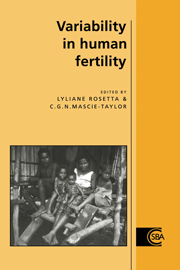Book contents
- Frontmatter
- Contents
- List of contributors
- 1 Introduction: the biological anthropological approach
- PART I HORMONAL ASPECTS OF FERTILITY REGULATION
- PART II INTERPOPULATION VARIABILITY
- 5 Age and developmental effects on human ovarian function
- 6 Non-pathological source of variability infertility: between/within subjects and between populations
- 7 The relationship between disease and subfecundity
- PART III METABOLIC AND ENERGETIC ASPECTS OF REGULATION
- Index
7 - The relationship between disease and subfecundity
Published online by Cambridge University Press: 03 February 2010
- Frontmatter
- Contents
- List of contributors
- 1 Introduction: the biological anthropological approach
- PART I HORMONAL ASPECTS OF FERTILITY REGULATION
- PART II INTERPOPULATION VARIABILITY
- 5 Age and developmental effects on human ovarian function
- 6 Non-pathological source of variability infertility: between/within subjects and between populations
- 7 The relationship between disease and subfecundity
- PART III METABOLIC AND ENERGETIC ASPECTS OF REGULATION
- Index
Summary
Introduction
There is enormous variation in individual fertility. The Guinness Book of Records 1993 (1992) reports the greatest officially recorded number of children born to one mother is 69, by the wife of a Russian peasant. In 27 confinements she gave birth to 16 pairs of twins, seven sets of triplets and four sets of quadruplets. The case was reported to Moscow by the Monastery of Nikolskiy on 27 February 1782. Currently, the most prolific mother is a Chilean, who in 1981, produced her 55th and last child. In polygamous societies the number of descendants can become incalculable. The last Sharifian Emperor of Morocco, Moulay Ismail (1672-1727) known as ‘ The Bloodthirsty ’ was reputed to have fathered a total of 525 sons and 342 daughters by 1703 and achieved a 700th son in 1721.
McFalls and McFalls (1984) estimate the maximum population fecundity, i.e. the average fecundity of the individual members of a population, at about 15 children per women. On that basis all populations are to a greater, or lesser extent, subfecund. The Hutterites, a religious sect living in North America, are generally acknowledged to be the most fertile population with an average of about 8 children per women while populations in the Bas-Uele district in Zaire illustrate the opposite extreme; nearly 50% of women aged 30-34 were found to be childless in the 1960s (Romaniuk, 1968) compared to only 2% of Hutterite women (Eaton & Mayer, 1954).
There are a number of reasons why the number of children per women varies within and between populations.
- Type
- Chapter
- Information
- Variability in Human Fertility , pp. 106 - 122Publisher: Cambridge University PressPrint publication year: 1996
- 1
- Cited by



